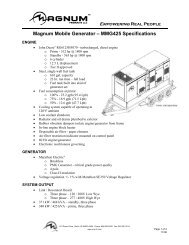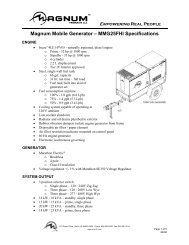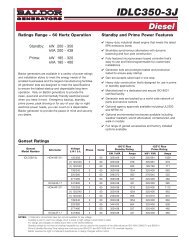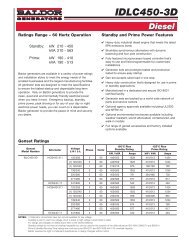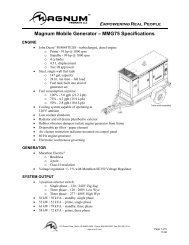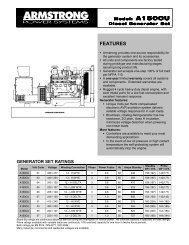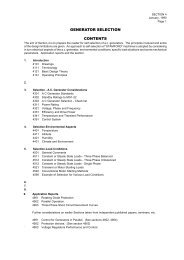GENERATOR SELECTION CONTENTS - Diesel Generator
GENERATOR SELECTION CONTENTS - Diesel Generator
GENERATOR SELECTION CONTENTS - Diesel Generator
You also want an ePaper? Increase the reach of your titles
YUMPU automatically turns print PDFs into web optimized ePapers that Google loves.
The diagram below illustrates the factors involved during load application and removal.<br />
NOTES:<br />
SECTION 4341<br />
January, 1990<br />
Page 2<br />
1. Voltage waveform envelope is shown as the heavy line.<br />
2. This diagram is not to scale and is intended to bring out the features<br />
mentioned in the text.<br />
These factors are described below and the standard performance of Newage ‘Stamford’ machines is also given.<br />
a) Transient Voltage Dip - the amount of transient voltage decrease due to the sudden application of a<br />
specified load usually expressed as a percentage of the original voltage level.<br />
b) Recovery Time - the length of time taken for the voltage level to recover to within 3% of the<br />
original value.<br />
c) Transient Voltage - the amount of transient voltage increase due to Overshoot the sudden<br />
removal of a specified load usually expressed as a percentage of the original<br />
voltage level.<br />
d) Steady Stage Regulation - a measure of the maximum permitted steady voltage changes over a wide<br />
variety of machine conditions (includes machine hot to cold variations: no load<br />
to full load applied, power factor 1.0 to 0.8 lag).<br />
In certain applications, a voltage dip better than our standard may be required - for example a 10% voltage dip on<br />
application of full load. The most effective way of achieving this is to provide a bigger a.c. generator. To assist in the<br />
correct selection of machines capable of this improved performance, graphs of applied load against voltage dip are<br />
included in Section 6 of this manual. Sometimes, when only small improvements to voltage dip are required, a special<br />
winding can be designed to give the correct performance without going to a larger machine. For this, reference to the<br />
factory is necessary.<br />
As with temperature, the standard transient performance should be considered first. Any improvement required in<br />
transient performance should have technical or economic justification.



